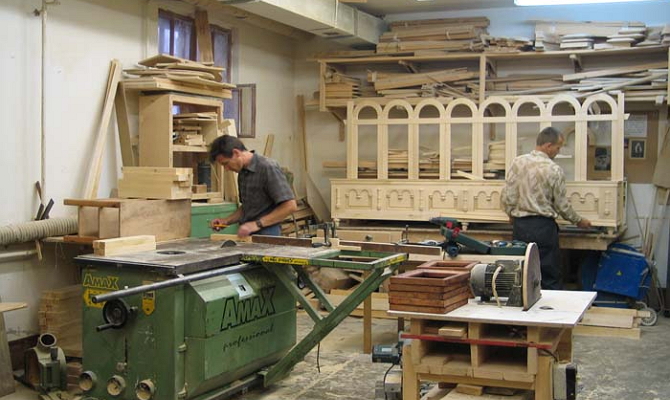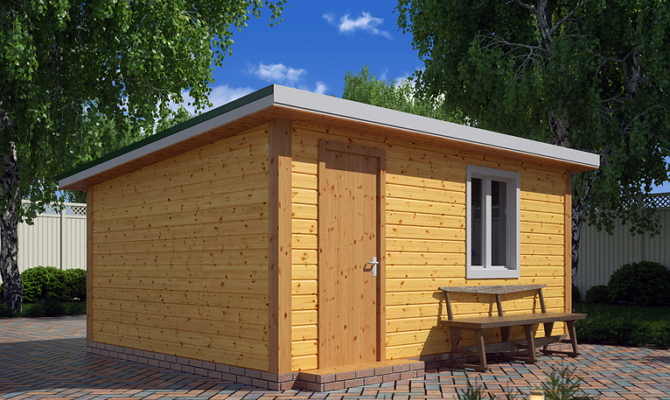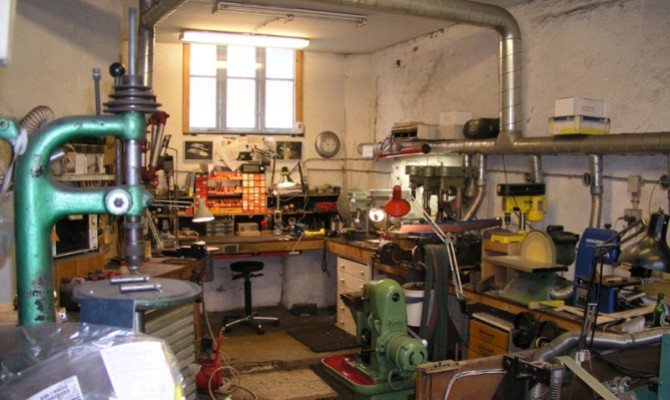Regardless of where you want to allocate a corner for your workshop, first of all, you need to make sure that it is located as far as possible from a residential building, for example, in a garage. It is not difficult to choose a place on the site, it will be much more difficult for those who, living in a city apartment, do not have a summer cottage or at least a garage, since they will have to put a workbench in one of the rooms. Ideally, a pantry can be allocated as a workshop, and a workbench can also be hidden in the hallway, in a built-in closet, or taken out to the loggia.
Further, everything is limited by the available area. If you only have a small booth at your disposal (a newsstand purchased on the occasion, or just a small hozblok), carefully work out the plan of the carpentry workshop. The less space available, the more you will be limited in equipment. In an area of 4 square meters, you can only place a workbench, a small grinder and, possibly, an anvil. But you still need to leave room for movement and, of course, do not forget the arrangement of cabinets with tools.

It will be most comfortable for you to work with your own hands in a separate barn with an area of at least 6 square meters or in a garage. After all, a carpenter needs not only a workbench, but also various machines, in particular a lathe and, if possible, a drill. Also, for fire safety, it is desirable to allocate space for a box of sand, a barrel of water and a box for sawdust. It is useful to put a rack for lumber near one of the walls or locate a workshop not far from. In order for a country carpentry workshop, equipped with your own hands at home or in a garage, to have a competent layout, it is worth watching a training video on this topic once.
So, a separate metal or built, but so far it's just a box. The most important thing at the next stage is high-quality sound insulation. It is unlikely that your household will enjoy listening to the squeal of an electric planer or the howl of a drill all day. Therefore, it is desirable to cover even the door with noise-absorbing material. The window, of course, will let sounds through freely, but it can be made on the opposite side of the residential building. At the same time, it is better to make the inner lining of walls and floors with your own hands from non-combustible materials or impregnate such popular fiberboard boards with a special fire retardant primer. How to do it better, the video instructions will tell you.

The second thing to do is to conduct electricity. Moreover, the cable must be multi-core, designed for heavy loads, especially if you plan to work with several machines and power tools at once. If the building is wooden, the wiring is placed in special metal boxes or pipes to avoid fire due to a short circuit. Sockets must be grounded, like the machines themselves. And, of course, take care of good lighting, fluorescent fluorescent lamps are best suited.
And finally, try not to forget about ventilation. Imagine for a moment how much wood dust is thrown into the air when you work with, say, an electric jigsaw. Some of it will settle on the workbench or on the floor, but you will definitely inhale some of it. Therefore, even the simplest exhaust system can make working conditions much more comfortable than a complete lack of ventilation. About how such an installation functions and how to mount it in the best way with your own hands, it is better to find out with the help of a video. At the same time, regardless of whether your workshop is in the barn, at home or in the garage, it is desirable to ensure not only the outflow of air with dust, but also the inflow of fresh air.

When arranging equipment, it is important to prioritize, for example, a drilling and turning machine is closer to the workbench, and a grinding machine is further away, while tools should be stored directly near the workplace.
There is usually not much space in the apartment for those who like to make something in their free time. There is a living room for the whole family to watch videos together and there is definitely no corner for a workbench. Even more so in the bedroom and kitchen. Therefore, the workshop within the walls of the house is either on the loggia, or in the pantry, less often - in the hallway, as mentioned above, in a closet converted into a workbench. Let's look at options for what a plan for a carpentry workshop could be.

If the balcony is spacious enough and insulated, it can be an ideal place for arranging your workshop, but if it is not glazed, work at the workbench will be seasonal. Therefore, first of all, it is advisable to take care of the frames and the heater. Further, a socket is displayed on the balcony, but here it is immediately worth remembering that the home electrical network is not designed for powerful machines, and the neighbors are unlikely to be delighted with the noise. Therefore, you will have to limit yourself to hand-held electric tools. But on the loggia there is perfect ventilation - just open the windows.
The worst inflow and outflow of air in the pantry, but it is convenient due to its isolation from residential and walk-through premises. True, in such a small room there is almost no space for a workbench, not to mention the equipment, so a wardrobe with a folding table would be the best solution. The first will store tools, and the second will become a work surface, not very reliable, but easily removed as unnecessary. You can find a video tutorial on how to make a compact workbench with your own hands.

And finally, we got to the wardrobe in the hallway, an almost perfect place for a work nook, especially with sufficient depth of the built-in wardrobe. Here you can make 2 compartments: narrow with shelves and wide with a workbench. The first will serve as a repository for tools that will always be at hand. The main thing is that the hinged doors hide both compartments behind them, otherwise you will have to constantly be distracted by looking behind the next door in search of a hammer or chisel.